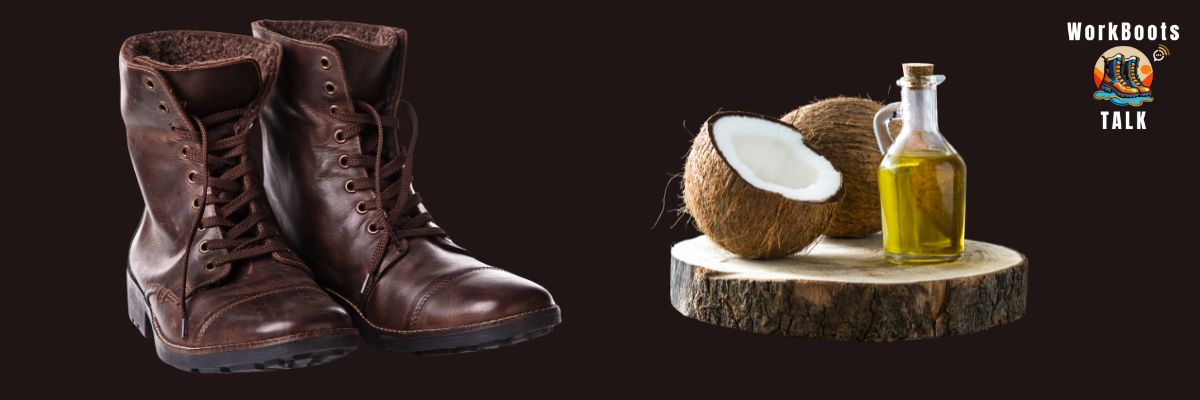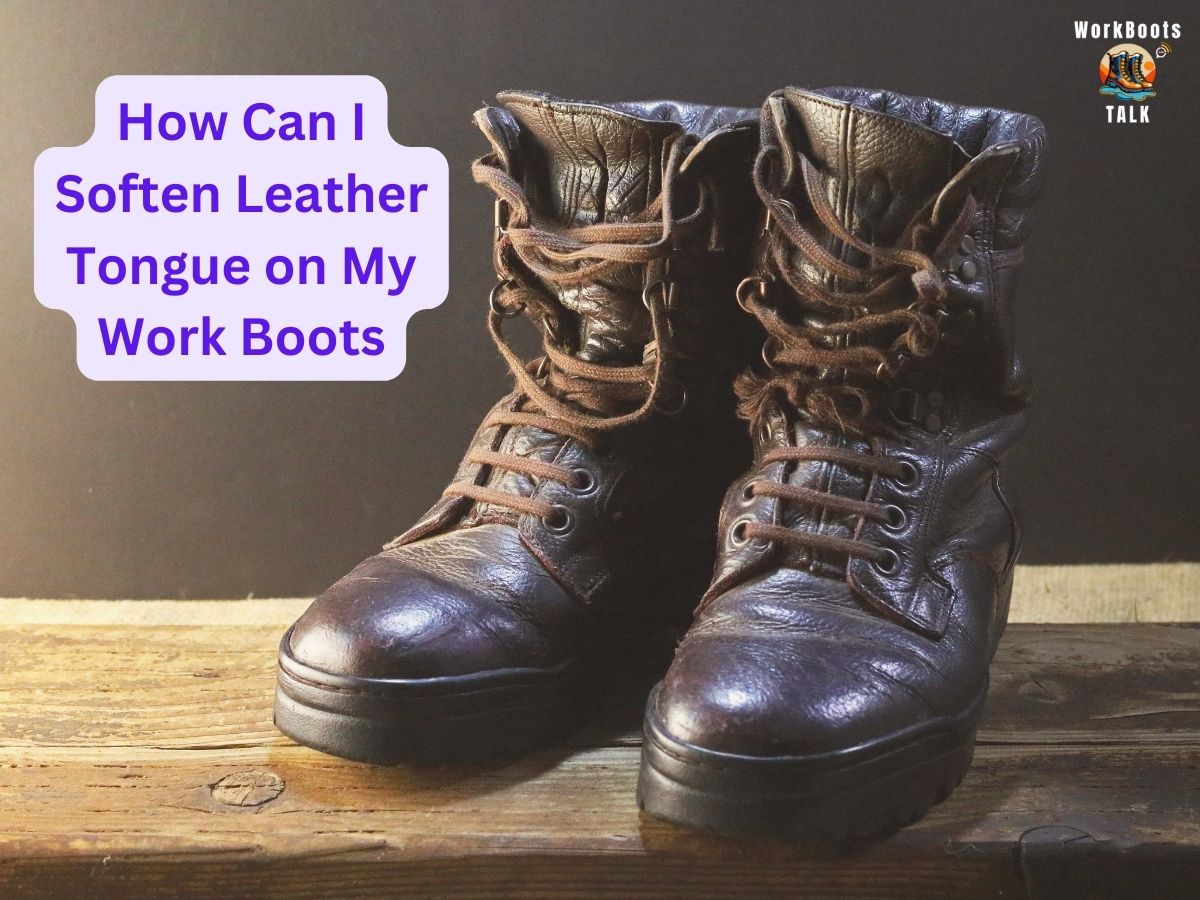Leather work boots stand out for their durability, protection, and style. However, they can be quite stiff and uncomfortable at first, particularly due to the leather tongue, which may cause blisters, chafing, and pain by rubbing against your feet. Learning how to soften the leather tongue allows you to fully enjoy the benefits of your boots without compromising on comfort. Thankfully, softening the leather tongue is an easy and affordable task that can be performed at home using some basic tools and materials. This guide will explain why it’s crucial for comfort to soften the leather tongue and how to do it using various methods. Additionally, you’ll receive advice on maintaining your softened leather tongue to avoid squeaking, molding, or cracking, ensuring lasting comfort and enjoyment from your work boots.
Why Softening the Leather Tongue is Essential for Comfort
The leather tongue, an integral part of the boot lying over the top of your foot and bridging the sides of the upper, is typically crafted from the same leather as the boot. Initially, it can be quite stiff and unyielding, leading to discomfort and potential foot issues, particularly for those in work boots for extended periods. We’ll delve into why it’s crucial to soften the leather tongue for optimal comfort and how this enhances your work boot experience.
Understanding the Structure of Work Boots
Work boots are engineered for durability, protection, and support, using robust materials like thick leather, rubber, or synthetics, alongside a solid sole and reinforced toe area. Their complex structure serves various purposes, distinguishing several key components:
- The upper: Encases the foot and ankle, typically in leather, available in styles such as lace-up, slip-on, or zipper.
- The insole: Sits inside the upper, providing cushioning and comfort with options for arch support, moisture-wicking, or anti-odour features, and can be removable or fixed.
- The midsole: Positioned between the insole and outsole to offer stability and absorb shock, crafted from materials like EVA, polyurethane, or a steel shank.
- The outsole: The boot’s ground-contacting layer, ensuring traction and durability with various materials and patterns like lug, wedge, or cleat.
- The heel: Raises the foot’s back for balance and support, customizable in height, shape, and material.
- The toe: Protects the front of the foot with options for steel, composite, or soft toe features, in shapes like round, square, or pointed.
- The tongue: Our focal point, this flap of leather atop the foot connects the boot’s sides, available in shapes and features like padded, perforated, or stitched.
Common Discomforts Associated with Hard Leather Tongues
Despite its critical role in fit, comfort, and boot performance, the leather tongue can lead to significant discomfort, particularly when stiff. Common issues include bunion irritation and heightened discomfort for those with hammertoes, both exacerbated by the stiff nature of untreated leather boots.:
- Blisters: These painful fluid-filled pockets arise from friction, heat, or pressure, posing risks of infection if untreated. Stiff tongues exacerbate this by rubbing against the skin.
- Chafing: Skin irritation from friction, moisture, or dirt, causing redness, itching, and potential infection. Hard tongues trap moisture and dirt, increasing friction.
- Pain: Discomfort from pressure on nerves and blood vessels, impacting mood and performance, is another drawback of stiff tongues.
The Benefits of a Softened Leather Tongue
Softening the leather tongue benefits not just in avoiding the issues mentioned but also in improving the overall comfort and functionality of your work boots. Advantages include:
- Fit: Conforming to your foot’s shape, a softened tongue ensures a snug fit, decreasing slipping, blisters, and discomfort.
- Flexibility: It allows your foot to move naturally, enhancing agility and reducing fatigue.
- Breathability: Promoting airflow and moisture evaporation, a soft tongue keeps your foot cooler and drier, minimizing infection risks.

Effective Methods to Soften the Leather Tongue
Understanding the importance of a soft leather tongue for enhanced comfort leads us to explore how to achieve this softness. There are several effective techniques you can choose from, based on your preferences, budget, and the resources you have at hand. In this guide, we’ll focus on three primary methods for softening the leather tongue: the use of leather conditioners, the application of natural oils, and various physical manipulation techniques.
Using Leather Conditioners
Leather conditioners are crafted to moisturize, nourish, and protect leather items, making them more pliable and supple in the process. You can find these conditioners in forms like creams, sprays, or wipes, and apply them using a soft cloth or brush. To soften the leather tongue with a conditioner, simply follow these steps:
- First, clean your boots using mild soap and water before thoroughly drying them.
- Select a leather conditioner suitable for your leather type, steering clear of any that contain harmful substances such as pine tar, castor oil, or mineral oils, to prevent damage.
- With a soft cloth or brush, apply a small amount of the conditioner, rubbing it in circular motions. Ensure you cover the entire tongue surface, reaching into any creases for uniform softness.
- Let the conditioner soak in for several hours or leave it overnight to fully absorb. To hasten the process, a hairdryer can be used cautiously to avoid leather damage.
- Repeat as necessary until the leather tongue achieves the desired level of softness.
Employing Natural Oils
Natural oils are another excellent approach to softening leather tongues, as they can deeply penetrate leather fibers to make them more flexible. These oils come from various natural sources like animals, plants, or fruits, each having unique benefits for leather. Popular options include mink oil, saddle soap, coconut oil, and foot oil.
- Start by cleaning your boots with mild soap and water; dry them well.
- Choose a natural oil compatible with your leather type, avoiding overly greasy, sticky, or acidic oils that could damage the leather.
- Apply a small amount of oil with a soft cloth or brush in circular motions over the entire tongue, including creases.
- Allow the oil to soak in for several hours or overnight. Using a hairdryer to speed up the process is optional, but caution is advised to prevent overheating.
- Repeat the application as needed until the softness meets your standards.
Maintenance and Long-Term Care for Softened Leather
Softening leather isn’t just a one-and-done deal. To ensure your softened leather stays in peak condition and doesn’t revert to being hard, consistent maintenance and care are crucial. In this guide, we’ll share actionable tips to maintain your softened leather and indicators that signal the need for professional assistance. Adhering to these suggestions will not only prolong the durability but also the comfort of your leather work boots.
Regular Conditioning
Regular conditioning stands out as a cornerstone practice in the upkeep of softened leather. Conditioning involves the use of products designed to hydrate, feed, and shield the leather. This practice wards off drying, cracking, or fading of the leather. Furthermore, it maintains the leather’s suppleness and flexibility. Here are the steps to effectively condition your leather:
Begin by gently cleaning the leather with mild soap and water, followed by thorough drying.
- Opt for a leather conditioner that aligns with your leather type, steering clear of those containing damaging chemicals like pine tar, castor oil, or mineral oils.
- Using a soft cloth or brush, apply a modest amount of conditioner in a circular motion across the leather surface, ensuring crevices and seams are also treated.
- Allow the leather to absorb the conditioner for a few hours or overnight. If you’re in a hurry, a hairdryer can expedite the process, but take caution to avoid overheating the leather.
- Buff off any residual conditioner with a clean cloth to enhance the leather’s soft lustre.
Conditioning frequency should be tailored to your usage rate and living climate, generally ranging from every six to twelve months.
Avoiding Potential Damages
Preventing damage is another vital aspect of preserving softened leather. Key culprits of leather damage include:
- Heat exposure, which can dry and crack the leather. Avoid direct sunlight, radiators, or fireplaces and store your boots in a cool, dry area.
- Moisture, which can lead to mold, mildew, or rot. Avoid submerging your leather in water or leaving it wet. Ensure your boots are dry after exposure to moisture and consider using a dehumidifier or silica gel packets for damp prevention.
- Dirt accumulation can block leather pores, rendering it dull and rough. Wear boots away from muddy or dusty areas, clean the leather regularly, and promptly address any stains.
- Friction, which can wear down leather and alter its shape. Avoid abrasive surfaces and use a shoe stretcher or horn to minimize leather creases or tears during wear.
When to Seek Professional Help
There are instances where professional intervention is necessary to manage and care for softened leather, especially when facing severe damage like holes, tears, or significant cracks. To locate a reliable leather repair service:
- Seek recommendations from your circle who own leather goods.
- Research online for nearby leather repair services, evaluating their reviews, ratings, and work samples.
- Consult a local shoe store or cobbler for repair service suggestions or direct referrals.
Before committing to a service, inquire about costs, warranties, and expected timelines. Communicate your goals and preferences clearly, and adhere to their leather care guidelines post-repair.
Softening Techniques for Different Leather Types:
Full-Grain Leather:
Conditioning with Oils: Full-grain leather tends to be naturally durable but can be initially stiff. Conditioning with oils like mink oil or beeswax-based products deeply penetrates the leather, promoting suppleness over time.
Regular Use: Consistent application of leather conditioners helps maintain the natural oils, preventing the leather from drying out and becoming rigid.
Top-Grain Leather:
Gentle Conditioning: Top-grain leather is typically more pliable than full-grain. Using a mild leather conditioner helps maintain its softness without compromising its inherent flexibility.
Avoid Overloading: While conditioning is beneficial, top-grain leather doesn’t require as much attention as its full-grain counterpart. Avoid overloading with products to prevent an overly soft texture.
Split-Grain Leather:
Careful Moisturization: Split-grain leather, being the inner layer, is more susceptible to drying out. Regularly applying a balanced leather conditioner helps preserve its softness.
Protection Against Dryness: As split-grain leather can be prone to dryness, it’s crucial to avoid prolonged exposure to extreme conditions, such as excessive heat or direct sunlight.
Tailoring your softening techniques to the specific characteristics of full-grain, top-grain, or split-grain leather ensures that your work boot tongues remain not only soft but also resilient over time. By understanding the unique needs of each leather type, you can optimize your softening routine for maximum comfort and longevity.
Conclusion:
In this piece, we’ve guided you through the process of softening the leather tongue of your work boots, highlighting the importance of comfort. We’ve introduced you to a variety of effective methods for achieving a softer leather tongue, including the use of leather conditioners, the application of natural oils, and various physical manipulation techniques. Additionally, we’ve offered advice on maintaining your newly softened leather tongue, safeguarding it against potential damage, and recognizing when it’s time to consult a professional for severe damage.
Armed with these steps and tips, you’re set to reap the benefits of wearing leather work boots without having to compromise on comfort. You’ll not only prolong the service life and enhance the performance of your boots but also prevent common issues like blisters, chafing, and discomfort. Expect improvements in fit, flexibility, breathability, and an overall boost in mobility and agility. Moreover, you’ll discover how to keep the leather tongue from issues like squeaking, molding, or cracking, ensuring it remains in top condition.
So, why wait? Take your work boots, and begin the process of softening the leather tongue right away. The remarkable difference it makes will surely impress you. Embrace the comfort of a softened leather tongue, and experience your work boots in an entirely new way.
Frequently Asked Questions
1. How do you soften a leather boot tongue?
Employ leather conditioners, oils, or natural methods like sun exposure to soften the boot tongue.
2. Will Vaseline soften boot leather?
While Vaseline can provide temporary softness, it’s not recommended for long-term use as it may attract dust and dirt.
3. What is the best oil to soften leather?
Mink oil, neatsfoot oil, or beeswax-based oils are popular choices for softening leather.
4. Can you use coconut oil to soften leather?
Yes, coconut oil is a natural option for softening leather, but use it sparingly to avoid a greasy residue.
5. Does glycerine soften leather?
Glycerine can help soften leather by retaining moisture, making it more supple.
6. Does massaging leather soften it?
Massaging leather can help distribute oils evenly, contributing to softening over time.
7. Can you use olive oil on leather?
Olive oil is suitable for softening leather, but excessive use may darken the leather.
8. Can I use vegetable oil on leather?
Vegetable oil can be used, but it may go rancid over time, and specialized leather oils are preferred.
9. Can any leather conditioner be used?
While many leather conditioners work, choose one appropriate for the specific type of leather in your boots.
10. What happens when you oil leather?
Oiling leather replenishes moisture, restores suppleness, and enhances the leather’s appearance by preventing it from drying out and cracking.

